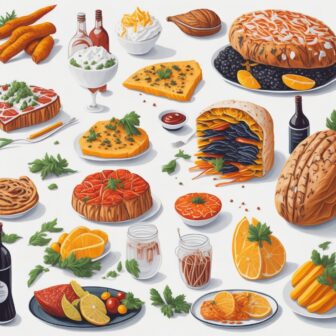20 Christmas Foods in Germany: What to eat and drink in Germany
Discover the delightful flavors of Germany with our list of 20 Christmas foods and drinks to savor during the holiday season. Christmas food in Germany is truly a delightful experience. Having visited countless German Christmas Markets over the years, you might think I’d lose interest, but the magic of Christmas never fails to captivate me anew, especially when I encounter the enticing aroma of delicious Christmas food.
In Germany, the timing of the Christmas dinner varies across regions and families, and it doesn’t always coincide with the exchange of presents. Some opt for a festive feast on Christmas Eve, either before or after the gift-giving tradition. Meanwhile, in other parts of Germany, Christmas Eve features a simpler, smaller dish, with the grandeur of the traditional Christmas dinner reserved for Christmas Day.
German Christmas food offers a rich tapestry of flavors and traditions that truly bring the holiday spirit to life. Whether you’re savoring roasted meats, sampling scrumptious sweets, or indulging in a warm mug of mulled wine, the culinary journey through a German Christmas is a treat for the senses.
So, if you’re planning to experience the magic of Christmas through its delectable cuisine, Germany should undoubtedly be on your list of must-visit destinations. Dive into the enchanting world of German Christmas food, and you’ll find yourself celebrating the season with a heartwarming blend of tradition and taste.
What to eat in Germany for Christmas
Traditionally, these are the main dishes on the table in Germany at Christmas: Christmas goose, carp, sausages with potato salad, raclette and fondue.
Advent cookies
Transforming your kitchen into a Christmas bakery is a surefire way to infuse your home with the holiday spirit. For many, the act of baking cookies, crafting cinnamon stars, and constructing gingerbread houses is a cherished and time-honored tradition leading up to Christmas. What’s more, this tradition offers a delicious payoff – a delightful array of treats to savor and share.
In countless households, baking German Christmas cookies stands as a lovingly nurtured custom, especially when there are children eagerly awaiting the festivities.
The tradition of baking during the Advent season has ancient roots, dating back to a time long before the birth of Christ. The Celts, in their wisdom, created a sacrificial bread, a flat cake crafted from flour and honey, which they suspended from strings. This ritual took place during the winter solstice and was believed to ward off malevolent spirits.
Among the many delectable holiday cookies savored by Germans in the four weeks leading up to Christmas, one standout favorite is the Vanillakipferl (vanilla crescents). These delicate delights encapsulate the essence of the season, making them a must-try for anyone seeking a taste of traditional German Christmas joy.
So, if you’re looking to infuse your home with the enchantment of the holiday season, gather your ingredients, dust off your baking utensils, and embark on a heartwarming journey of festive baking. Your kitchen will soon be filled with the comforting scents of the holidays, and your heart with the warmth of cherished traditions.
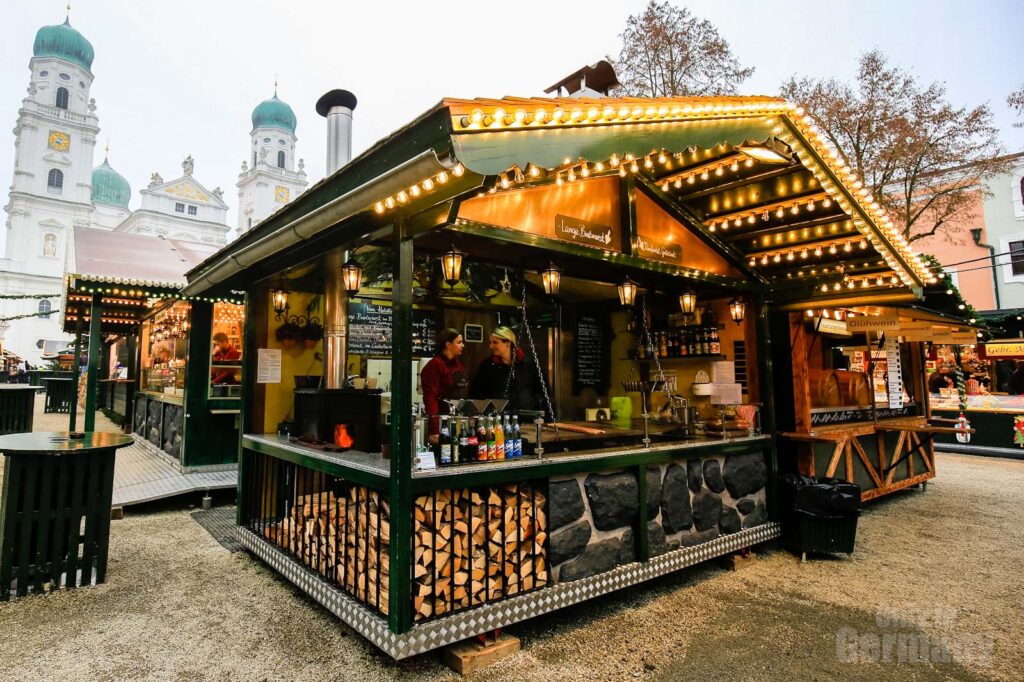
Potato salad & Christmas Meals
In old Christian tradition, Lent spanned from St. Martin’s Day on November 11th to December 24th. This historical fasting period shaped the way Germans celebrate Christmas with specific dishes.
On Christmas Eve, a simple dish takes center stage, often featuring carp, as fish symbolizes fasting. However, across the country, the most beloved choice is potato salad with sausages, a heartwarming favorite.
As Christmas Day dawns, the festivities continue with a sumptuous feast laid out on a beautifully decorated table. The quintessential German Christmas dinner stars a mouthwatering roast goose paired with potato dumplings and red cabbage.
Indeed, Christmas in Germany wouldn’t be complete without a lavish family meal, featuring either the classic Christmas goose or carp, accompanied by meticulously crafted seasonal cookies. In some regions, simpler dishes like stew make an appearance on Christmas Eve, adding regional diversity to this cherished holiday tradition.
These age-old culinary customs add a rich layer of tradition to the joyous celebrations, making German Christmas food a delightful journey through time and taste.
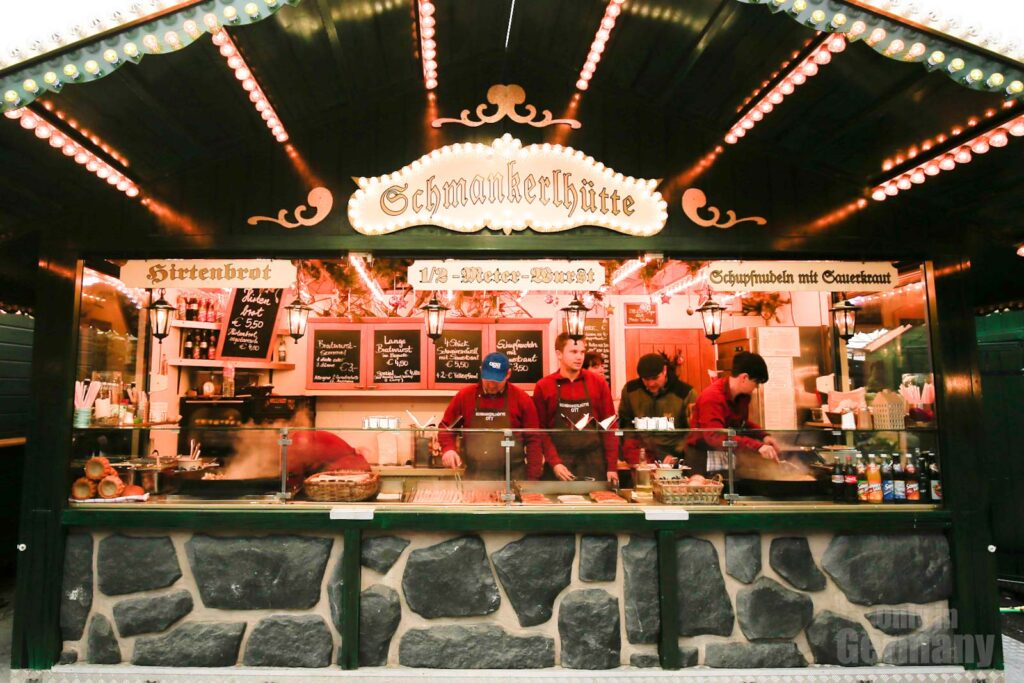
The Pflaumentoffel: A Sweet Tradition with a Unique Origin
The Pflaumentoffel, a curious edible figure crafted from dried or prunes, holds a special place in German holiday traditions. These delightful creations are brought to life by skilled bakers, pastry shops, and even young gingerbread enthusiasts. Their fame spread through their availability at the renowned Dresden Striezelmarkt.
Resembling a chimney sweep, the Pflaumentoffel is constructed from approximately 14 dried or baked plums, with additional elements including wooden sticks, a painted paper ball for the head, a cardboard cylinder serving as headgear, a shoulder cape, and a paper ladder adorned with shimmering metal foil.
The inspiration for the Pflaumentoffel harks back to a unique slice of history: young boys, typically aged seven to eight, often from orphanages, were permitted to work under master sweepers’ guidance with the approval of the Electoral Saxons back in 1653. Their task? To crawl through and clean the tight, lofty chimneys of townhouses. This practice, seen from today’s perspective, raises eyebrows as an early example of state-sanctioned child labor.
However, the Pflaumentoffel has transformed into a symbol of good luck, offering a reinterpretation of the darker aspect of child labor through humor and various German Christmas customs. It’s reminiscent of chimney sweeps as symbols of good fortune and echoes the tradition of St. Nicholas making his entrance through the chimney in some parts of Europe, or the hanging of stockings by the fireplace to be filled with sweets.
Moreover, there might be a pedagogical intention behind the Pflaumentoffel, reminding mischievous children of the so-called “black man” when they exhibit behavioral issues. This unique tradition weaves together history, humor, and cultural symbolism, making the Pflaumentoffel a fascinating and delicious part of German Christmas lore.
RELATED:
Best Hotels in Dresden
Best Places to Visit in Dresden
German Stollen: A 700-Year-Old Christmas Tradition
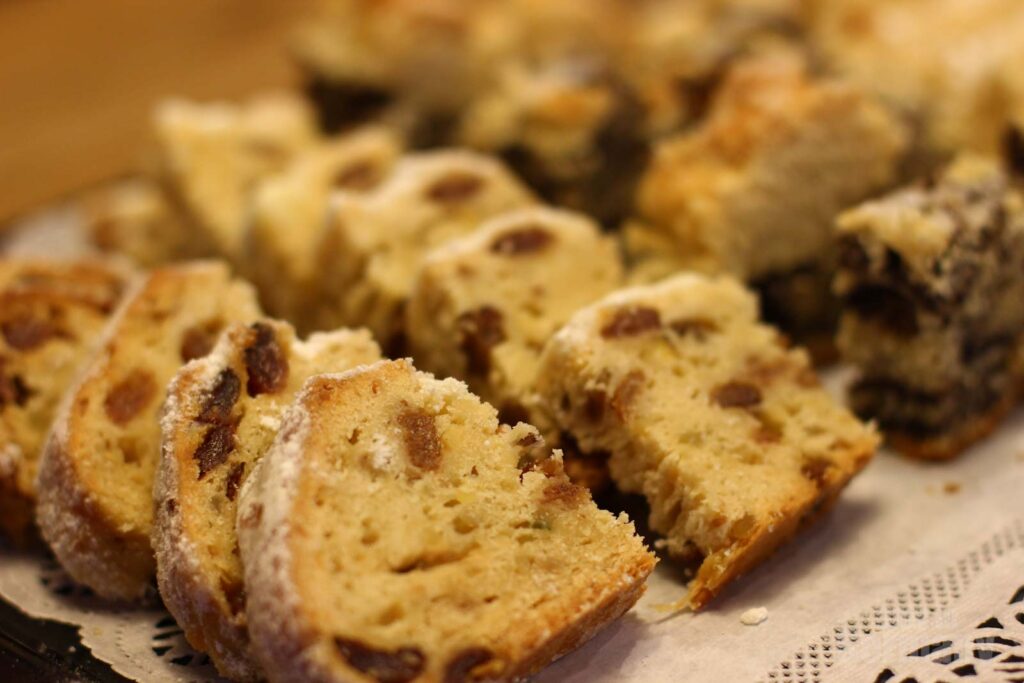
German Stollen, cherished for over seven centuries, holds a special place in the hearts and palates of Christmas enthusiasts. These homemade delights are a testament to tradition, boasting a flaky, moist, and irresistibly delicious texture.
Picture this: a cozy afternoon, a cup of tea, and a slice of traditional German Christstollen to warm your soul on a chilly, dreary day. Also known as Weihnachtsstollen, this treat is a luxurious fruit bread adorned with a delicate dusting of icing sugar.
What makes Stollen truly special is its sumptuous filling, comprising almonds, marzipan, dried or candied fruit, and sometimes even a hint of rum or brandy. To elevate its flavor profile, holiday spices like nutmeg, cardamom, and vanilla are added.
Among the various Stollen varieties, the Dresden Christstollen stands out as an iconic representation of this age-old tradition. First documented in the 13th century, it’s a culinary masterpiece that enjoys a unique status. Interestingly, only around 120 bakeries in the eastern German city of Dresden are legally authorized to produce this esteemed Stollen.
Dresden pays tribute to this beloved tradition every year during Advent with a significant event that celebrates the Stollen, emphasizing its enduring significance in German Christmas culture. So, as you savor a slice of this time-honored treat, you’re not just tasting a dessert but also partaking in a centuries-old tradition filled with warmth and flavor.
Marzipan Delights: A Sweet Tradition in German Christmas Cuisine
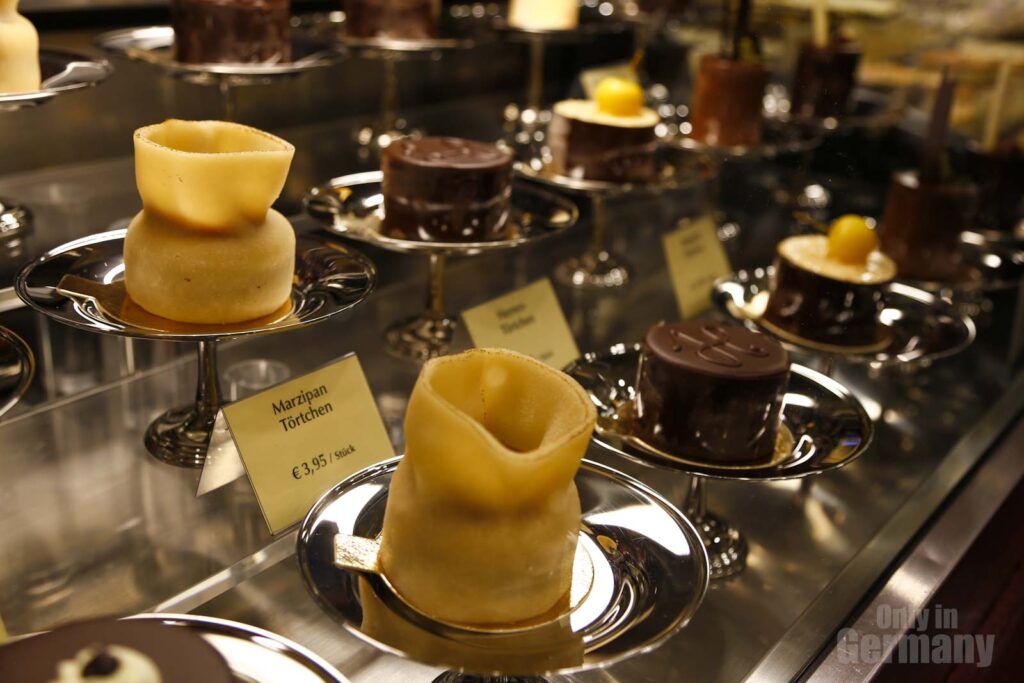
Marzipan, a beloved ingredient, takes on various delightful forms in German Christmas delicacies, adding a touch of sweetness and creativity to the holiday season.
First, we have Marzipankartoffel, or marzipan potatoes, which are simple yet delectable marzipan-and-sugar balls dusted with cocoa powder and cinnamon. They offer an irresistible blend of textures and flavors.
Marzipan also shines in the shape of small loaves, known as Marzipanbrot or marzipan bread. These loaves can be enjoyed plain or enrobed in chocolate, with flavors ranging from cranberries to the richness of rum.
For a whimsical twist, marzipan is molded into colorful animal shapes, with pigs being a particularly popular choice. These cute creatures, considered symbols of luck, make for charming gifts, especially around New Year’s.
Marzipan’s versatility extends to traditional German treats like Stollen and Dominosteine, where it plays a pivotal role in enhancing their taste and texture. If you’re in the mood for a sip of something sweet, keep an eye out for Marzipanlikör, a liqueur that captures the essence of marzipan in liquid form.
While marzipan can be found throughout Germany, it’s Lübeck in the north that is renowned for its marzipan production. In fact, Lübecker Marzipan holds a Protected Geographical Indication status, signifying that it must be entirely or at least partially crafted in Lübeck to bear this name within the EU.
One of the most esteemed purveyors of high-quality marzipan in Germany is Niederegger, a brand with its roots in Lübeck since 1806. Their commitment to crafting exceptional marzipan continues to sweeten the holiday traditions of many.
Sausages: The Heart of a German Christmas Market
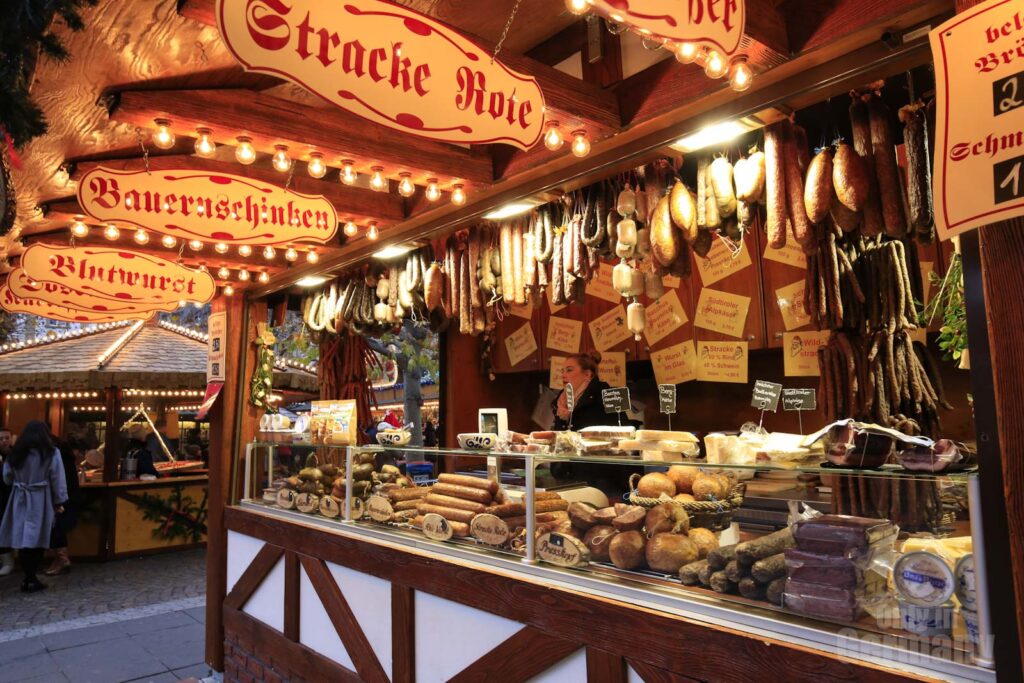
Imagine a German Christmas market without sausages – it’s like Santa Claus without his iconic beard. Sausages are an integral part of the holiday festivities, and at these markets, you’ll find a delightful array of options to satisfy your cravings.
Brätwurst reigns supreme, a traditional white German pork sausage that can stretch up to a whopping half a meter. Its hearty, savory goodness embodies the essence of the season.
For those seeking a little extra warmth on chilly Christmas nights, Feuerwurst (fire sausage) is the answer. This spicier option adds a kick to your taste buds, offering a delightful contrast to the milder Krakauer, a red bratwurst with a more subdued flavor.
Venture further, and you’ll discover the tempting allure of Käsewurst, a cheese sausage, or the legendary currywurst – thinly sliced brätwurst bathed in a delectable curry-ketchup sauce. Alternatively, indulge in Frankfurter Würstchen, gently heated in brine, for a taste of tradition with a twist.
No matter your choice, one rule remains sacred: these sausages must be cradled in a warm bun, accompanied by a generous drizzle of ketchup or mustard, and, for those who desire an extra layer of flavor and texture, fried Zweibeln (onions).
So, as you wander through the enchanting stalls of a German Christmas market, make sure to savor the sizzling symphony of sausages, adding a hearty and savory note to your holiday experience.
Dampfnudeln: A German Christmas Market Classic
While Dampfnudeln enjoy year-round popularity in certain regions of Germany, they truly shine as a staple at German Christmas markets around the world.
These sweet, yeasted dumplings owe their name to the steaming method, or “dampfen,” used in their preparation. Dampfnudeln are lovingly crafted by simmering them in a covered stovetop saucepan, typically with either butter and milk or salt water and fat. This process results in their unique texture and flavor.
Debate has long swirled over whether the Palatinate or Bavaria can claim the origins of Dampfnudeln, and these regions each have their own distinct methods of preparation and consumption. Regardless of their origin, Dampfnudeln share certain characteristics: they are always plump, snowy white, and possess a light, bread-like consistency.
In the Palatinate, a delightful twist is added—a crispy, golden brown bottom that adds an irresistible contrast to the soft and fluffy top. This touch has since spread to other regions, enhancing the overall appeal of these beloved dumplings.
So, whether you find yourself in the heart of the Palatinate, Bavaria, or a German Christmas market abroad, don’t miss the chance to savor Dampfnudeln, a delightful treat that captures the essence of German culinary tradition.
Gänsebraten: A Culinary Crown Jewel of German Christmas
Gänsebraten, or roast goose, holds a special place in the hearts and plates of many Germans during the festive Christmas season. This mouthwatering dish represents a cherished tradition, bringing families and friends together to celebrate the joy of Advent.
The preparation of Gänsebraten is nothing short of an art form. A plump and succulent goose is expertly roasted to perfection, resulting in crispy, golden-brown skin that crackles with each bite. The rich and savory aroma that fills the kitchen as the goose slowly roasts is enough to make anyone’s mouth water with anticipation.
When it’s time to serve this festive masterpiece, it’s typically accompanied by a symphony of complementary flavors. Braised red cabbage lends a sweet and tangy contrast, its deep purplish hue providing a feast for the eyes as well as the taste buds. A luxuriously flavorful sauce, often made from the goose’s own juices, adds a velvety touch, while potato dumplings provide a satisfying and hearty element to the plate.
Gänsebraten is more than just a meal; it’s a symbol of togetherness and celebration. Families gather around the table, the room filled with laughter and warmth, as they share in the joy of the season. Each bite of tender goose meat carries with it a sense of tradition and history, reminding all present of the rich cultural heritage that makes German Christmases so special.
So, as the aroma of Gänsebraten fills the air, and the table is set with all its accompaniments, it’s not just a meal but a heartwarming experience, a true embodiment of the spirit of Christmas in Germany.
Christmas Market Sweets: A Sugary Wonderland
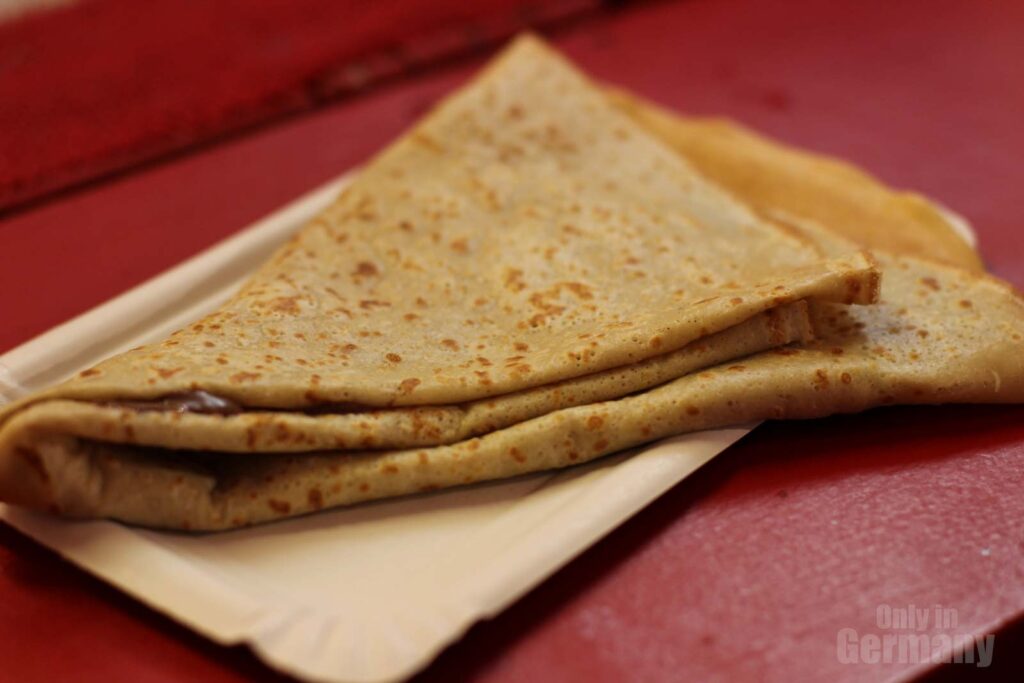
A visit to a German Christmas market is like stepping into a sugary snowdrift of delightful treats and sweets. Germans have a deep-rooted affection for their pannfkuchen, or crepes, which serve as a canvas for an array of tantalizing toppings. Picture a warm crepe adorned with fragrant cinnamon, creamy Nutella, velvety eggnog, luscious Kinder chocolate, and the subtle sweetness of marzipan, all kissed by the warm embrace of Grand Marnier. These creations are a testament to the creativity and love for flavors that define German Christmas markets.
As you meander through the market, you’ll come across a sign that reads “Nussknacker”, leading you to a colorful assembly of nutcrackers transformed into whimsical toy soldiers, adding a touch of whimsy to the festive atmosphere.
But the sweet indulgences don’t stop there. Candied almonds, infused with a medley of flavors like mint, toffee, eggnog, amaretto, and Nutella, beckon you to experience their crunchy, irresistible allure. For a convenient on-the-go treat, there’s the paradies apfel (toffee apple), also known as the schoko apfel (chocolate apple), skewered and ready to delight your taste buds. Holding one in hand, you’re free to savor a plump Berliner, a well-known Eastern German doughnut filled with either jam or custard and topped with a delightful array of toppings, from succulent strawberries to the rich decadence of Black Forest gâteau, fluffy marshmallows, and more.
Yet, amidst this sugary wonderland, it’s the plätzchen cookies that may embody the very essence of Christmas in Germany. Crafted into festive motifs, from Christmas trees that twinkle with sugar crystals to tiny Santas with icing caps, these cookies are the epitome of Christmastime sweetness. Among them, the Lebkuchen-plätzchen stands as a star, a gingerbread delight generously covered in chocolate and adorned with warm holiday greetings. These little treasures capture the heart and soul of German holiday traditions, making each bite a celebration of the season’s spirit.
So, as you explore a German Christmas market, be prepared for a sensory journey through a world of sweet delights, where every treat tells a story of tradition, creativity, and the joyous essence of Christmas.
Lebkuchen: A Medieval Culinary Marvel from Franconia
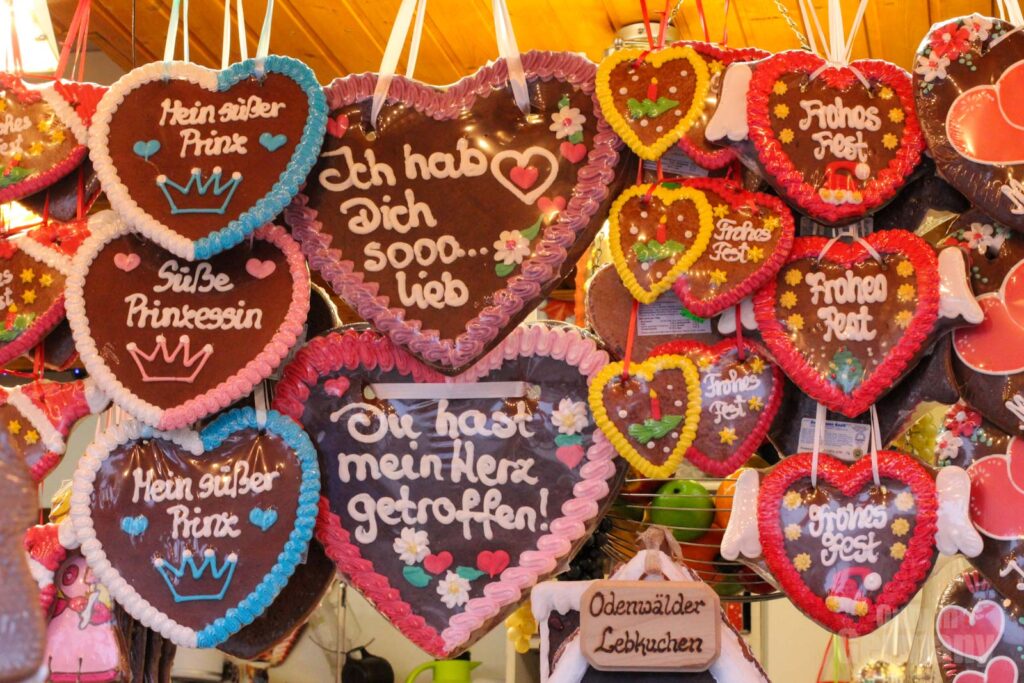
Lebkuchen, with its origins tracing back to medieval Franconia, an area that now primarily falls within Bavaria, is a delightful confection that shares similarities with gingerbread. This festive treat is renowned for its soft, warmly spiced, and slightly chewy texture, making it a beloved staple during the holiday season.
What makes Lebkuchen particularly fascinating is its rich diversity, with various regional varieties reflecting the unique culinary traditions of different German locales. Just like the tapestry of Germany’s culinary landscape, Lebkuchen can range from intensely spiced to mild and sweet, catering to a spectrum of palates.
In crafting Lebkuchen, a harmonious blend of spices and ingredients comes into play. Allspice, aniseed, cardamom, cloves, coriander, ginger, nutmeg, and vanilla lend their aromatic notes to the mix, creating a symphony of flavors. Alongside these spices, honey and crushed nuts, including almonds, hazelnuts, and walnuts, infuse Lebkuchen with a distinctive sweetness and texture.
To add a touch of decadence, Lebkuchen are often treated to a generous coat of chocolate, providing a luscious contrast to the spice-infused interior. They may also sport a clear sugar coating, which not only enhances their appearance but also contributes to their delightful texture. Further embellished with a sprinkle of nuts, Lebkuchen become an edible work of art, inviting you to savor the season’s sweetest moments.
In essence, Lebkuchen embodies the essence of German culinary craftsmanship—a delightful blend of tradition, flavor, and creativity that warms the heart and delights the senses during the holiday season. Each bite is a journey through history, a testament to the enduring joy of sharing delicious moments with loved ones.
Schneebällchen: A Sweet Delight from Franconia to the World
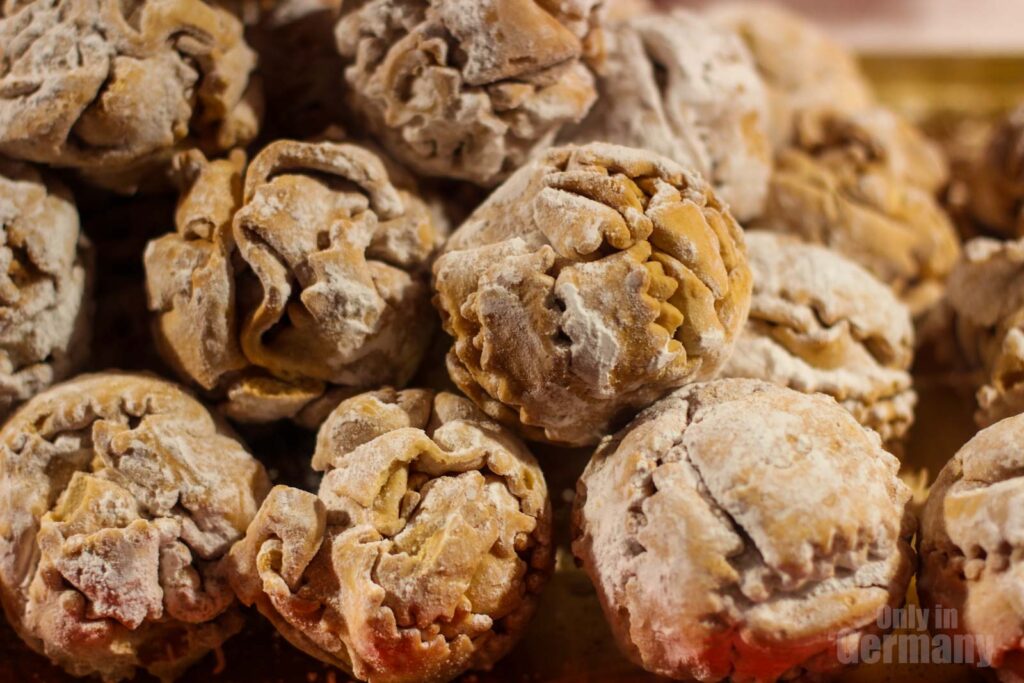
Schneebällchen, often lovingly referred to as “little snowballs,” may not be actual snowballs, nor are they tiny holiday cocktails. Instead, these delectable treats are a culinary masterpiece crafted from deep-fried shortcrust pastry balls, each roughly the size of an orange, and adorned with a whimsical dusting of sugar, chocolate, or finely chopped nuts.
Hailing originally from Franconia and the northern reaches of Baden-Württemberg, Schneebällchen have become beloved symbols of German holiday traditions. These delightful creations have transcended their regional origins and can now be found stacked high at German Christmas market booths across the country and even beyond.
Schneebällchen are a testament to the artistry of German bakers, who transform humble ingredients into enchanting spheres of sweetness. The shortcrust pastry, golden and flaky from deep-frying, provides a satisfying crunch as you bite into it. The sugar, chocolate, or nuts coating each ball add layers of flavor and texture, creating a delightful symphony for your taste buds.
As you indulge in Schneebällchen, you’re not just savoring a delicious treat; you’re immersing yourself in the rich tapestry of German holiday traditions. Each bite is a reminder of the joy and warmth that the holiday season brings, a small yet sweet celebration that transcends borders and unites hearts.
So, whether you find yourself in Franconia, Baden-Württemberg, or a bustling German Christmas market elsewhere, don’t miss the opportunity to taste the magic of Schneebällchen—delightful orbs of sweetness that have captured the essence of the holiday spirit and are bound to put a smile on your face.
Reibekuchen: A German Potato Pancake Delight
Across several European nations, including Germany, potato pancakes hold a cherished place in culinary traditions, each country adding its unique twist to this humble yet delicious dish. In Germany, these pancakes, known as Reibekuchen, go by various regional names such as Kartoffelpuffer, Reiberdatschi, Rievkooche, Grumbeerkiecheln, and Erdäpfelpuffer.
The creation of Reibekuchen involves a simple yet delightful combination of ingredients: eggs, flour, finely grated potato, and onion, perhaps seasoned with a hint of nutmeg. This medley results in a batter that, when fried to a golden crisp, transforms into delectable potato pancakes. The crispy exterior contrasts perfectly with the soft, tender interior, creating a textural symphony that is irresistible.
Reibekuchen’s versatility is one of its hallmarks. You can find them on restaurant menus year-round, serving as both a sweet and savory side dish. Paired with fruit sauces like apple or cranberry, they take on a sweeter note that complements a variety of main courses. However, their moment of glory arrives during the holiday season when they become a staple of German Christmas markets.
At these festive markets, Reibekuchen are often served hot and fresh, with a sprinkling of powdered sugar or a dollop of apple sauce, enhancing their seasonal charm. One particularly delightful pairing is with smoked salmon, where the rich, savory flavors of the fish harmonize beautifully with the potato pancakes.
Whether enjoyed as a comforting side dish or as a star attraction at Christmas markets, Reibekuchen encapsulate the heartwarming essence of German cuisine. Each crispy bite is a taste of tradition and a reminder of the joyous gatherings that define the holiday season in Germany.
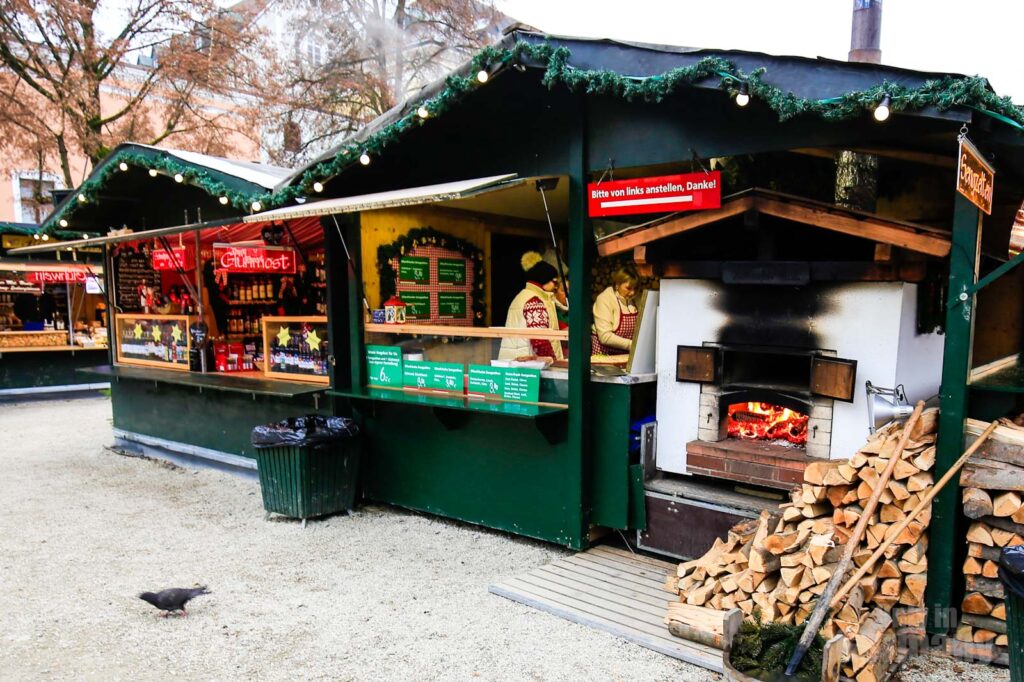
Springerle: The Intricately Carved Delights of German Christmas
Springerle, those charming rectangular German Christmas cookies, are a testament to both artistry and tradition. What sets them apart is not just their delightful flavor but also the unique rolling pin used to create their intricate patterns.
The process of making Springerle begins with a straightforward yet magical combination of ingredients: eggs, sugar, and flour, skillfully blended to form a smooth dough. However, it’s the artistic touch that elevates these cookies to a whole new level.
The secret lies in the rolling pin, a masterfully carved work of art in itself. This rolling pin is intricately adorned with intricate patterns and designs, often depicting scenes from daily life or featuring festive motifs. As the dough is rolled out with this special pin, it leaves behind the imprint of these detailed designs on the surface.
But Springerle’s unique flavor comes not from the dough itself but from a clever technique involving crushed anise seeds. These aromatic seeds are not mixed into the dough but are instead generously scattered onto the baking sheet. As the Springerle cookies are placed on top, they pick up the anise seeds, infusing them with a delicate, aromatic essence.
The result is not just cookies but edible works of art, each one telling a story through its carefully carved design. Springerle are a reminder of the craftsmanship and creativity that go into German holiday traditions, where even the simplest treats become a canvas for artistic expression.
So, as you savor a Springerle cookie, you’re not just enjoying a sweet treat; you’re indulging in a piece of history and culture, a symbol of the festive spirit that fills German homes during the Christmas season.
Quarkbällchen: Sweet Spheres of Delight from Germany
Quarkbällchen, those irresistible small quark balls, are a deep-fried treat that epitomizes the sweet pleasures of German cuisine. These delectable morsels, sweetened with vanilla sugar, bear a striking resemblance to golf ball-sized doughnuts but have a unique and delightful twist that sets them apart.
What makes Quarkbällchen truly special is the incorporation of quark, a fresh cheese derived from curdled sour milk, into the batter. This addition imparts a wonderfully soft and light texture to the treats, setting them apart from their denser counterparts. Each bite is a harmonious blend of sweetness and creaminess, making Quarkbällchen an irresistible indulgence.
While Quarkbällchen can be found throughout Germany year-round, they take on a special significance during the holiday season, particularly at German Christmas markets. Here, these delightful spheres of sweetness are deep-fried to order, ensuring they arrive at your plate piping hot and perfectly fresh. They are often served on rectangular paper plates, generously dusted with white powdered sugar, creating an enchanting snowy effect that enhances their seasonal charm.
As you savor a Quarkbällchen at a German Christmas market, you’re not just tasting a sweet treat; you’re immersing yourself in a cherished tradition. The festive atmosphere, the warmth of the holiday season, and the delightful flavors of these quark-infused delights all come together to create a truly magical experience.
So, whether you enjoy them at a local café or indulge at a bustling Christmas market, Quarkbällchen are a reminder of the joyous spirit of the season, where simple yet scrumptious treats bring smiles and warm hearts.
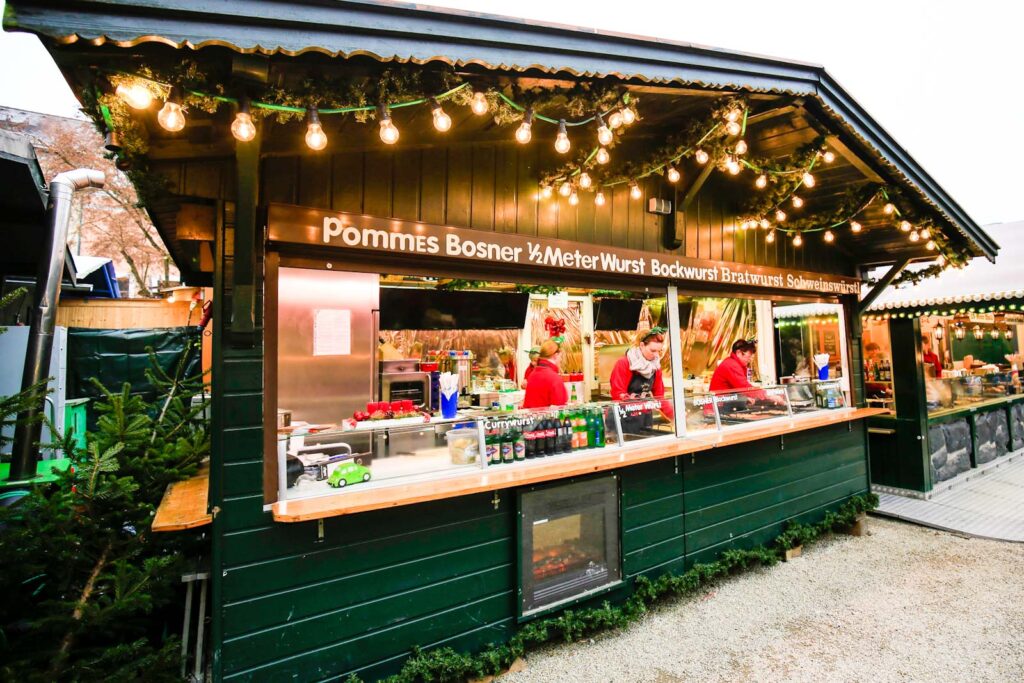
Bethmännchen: Frankfurt’s Adorable Christmas Pastries
In Frankfurt, during the Advent season, a delightful tradition unfolds in the form of Bethmännchen—tiny, chubby, and lightly browned Christmas pastries that capture the essence of the holiday spirit. These little treasures are a beloved part of the seasonal celebrations.
Bethmännchen are petite, ball-shaped pastries with flat tops and bottoms, each one a work of art crafted from a blend of flour, icing sugar, marzipan, eggs, and a delicate touch of rosewater flavoring. This unique combination results in a delectable treat that is both tender and subtly aromatic.
What makes Bethmännchen truly charming is their distinctive garnish. Three halved, skinned almonds are lovingly placed on the edges of these pastry balls, adding a touch of visual elegance and a delightful crunch to each bite.
Bethmännchen’s appeal extends beyond their flavor and appearance. They are a symbol of tradition and togetherness, evoking warm memories of family gatherings during the holiday season in Frankfurt.
Pralinen: Decadent Delights for Every Season
While Bethmännchen may be a specialty of the Advent season, another sweet indulgence, Pralinen (pralines), takes center stage year-round in chocolate shops and pastry boutiques across Germany. However, these delightful treats find a special place in hearts during the holiday season.
During this festive time, Pralinen often take on a seasonal twist, with variations that include warming spices, luscious marzipan, liqueur-infused centers, crunchy nuts, or smooth nougat fillings. Wrapped in elegant packaging, they become cherished gifts exchanged among friends and loved ones, embodying the spirit of giving and sharing during the most wonderful time of the year.
So, as you enjoy Bethmännchen in Frankfurt or savor Pralinen from a local chocolatier, you’re not just treating yourself to delectable sweets but also partaking in the rich tapestry of German holiday traditions, where every bite tells a story of warmth, joy, and togetherness.
RELATED
German Christmas Traditions: what to do in Germany for Christmas
German Christmas Traditions: what to drink in Germany for Christmas
Germans are skilled drinkers, especially around Christmas. So anticipate drinking plenty of golden pilsner, hop-infused weissbier, and malty dunkel or dark beer.
Glühwein: Warmth in a Mug with a Festive Twist
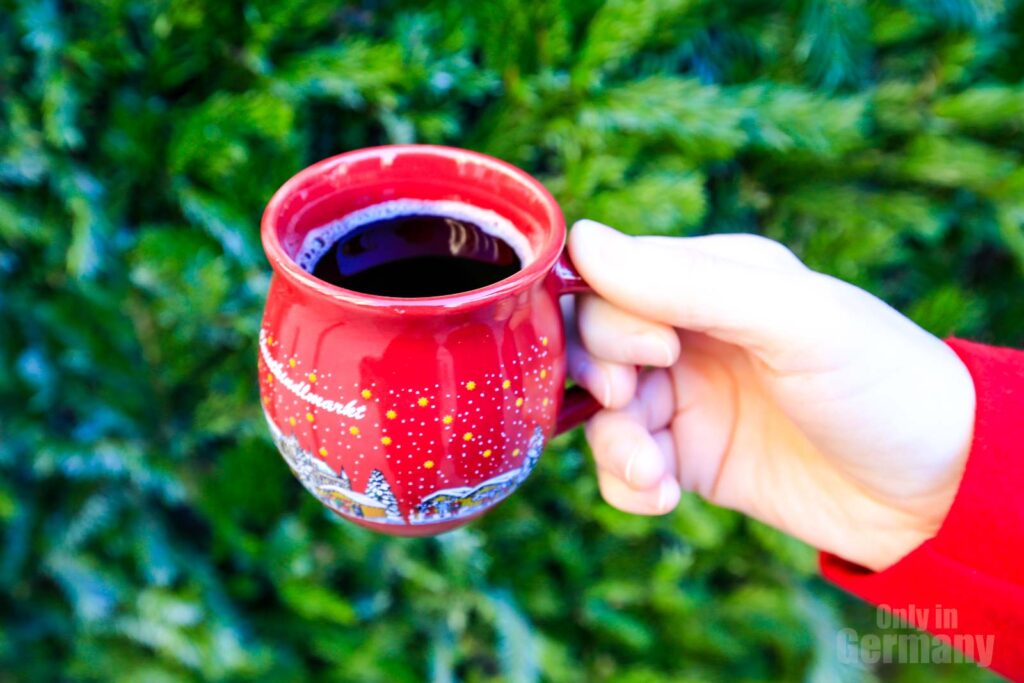
Glühwein, the hot alcoholic elixir that graces German Christmas markets, is more than just a beverage; it’s a soothing embrace of warmth and tradition. This delightful concoction is created by gently heating wine with sugar, a harmonious blend of spices that might include star anise, cinnamon, and cloves, and a touch of citrus peel or juice.
While Glühwein is often associated with red wine, its versatility knows no bounds. You may find variations made with blueberry wine, raspberry wine, or even kirschwein—cherry wine derived from dark, tart morello cherries. Each sip is a symphony of flavors, a fragrant medley that warms the soul during the frosty holiday season.
At large German Christmas markets, convenience often reigns, with prepackaged wine and spice blends used consistently across stalls. These regulated recipes tend to yield a sweeter, more uniform Glühwein experience.
However, for those seeking a more nuanced and less sugary rendition, there’s Winzerglühwein. This mulled wine is crafted by winemakers who use their own wines and follow their unique recipes, resulting in a drink that reflects their expertise and regional character. Wineries often set up booths at Christmas markets in various wine regions of Germany, providing an opportunity to savor Glühwein with a distinct twist.
So, as you wander through the enchanting stalls of a German Christmas market, be sure to cradle a mug of Glühwein, a comforting tradition that not only warms your body but also fills your heart with the festive spirit of the season.
Feuerzangenbowle: Ignite the Magic of Mulled Wine
For those who adore the comforting embrace of mulled wine on a chilly winter evening but yearn for an extra dash of excitement, Feuerzangenbowle is the answer to your holiday beverage dreams. Imagine the thrill of lighting a rum-soaked, cone-shaped sugar cube on fire and allowing it to drip, like liquid gold, into a mug of hot, spiced red (or occasionally white) wine.
Feuerzangenbowle, which literally translates to “fire tongs punch,” is a beloved and spirited concoction that takes mulled wine to a whole new level. It’s a star attraction at Christmas markets throughout Germany, where the festive atmosphere is complemented by the spectacle of flames dancing atop sugar loaves.
The process is a mesmerizing experience in itself. First, a cone-shaped sugar cube is soaked in rum, and then it’s carefully set ablaze. Positioned over a mug filled with hot, aromatic spiced wine, the sugar drips down like liquid fire, infusing the wine with rich, caramelized sweetness. The resulting drink is a harmonious blend of warmth, spice, and the spirited essence of the holiday season.
At Feuerzangenbowle stands, the drama continues as rum is ladled atop the blazing sugar loaves, ensuring that every last drop of sugary goodness is incorporated into the drink. The result is a beverage that not only warms your body but also ignites your spirit with the festive joy of the season.
So, if you’re seeking a truly magical and exhilarating twist on mulled wine, look no further than Feuerzangenbowle. It’s a delightful reminder that even the simplest traditions can be elevated to extraordinary heights, turning a winter evening into an unforgettable experience of warmth and wonder.
Schneemann Punsch: A German Drink to Defrost Your Spirit
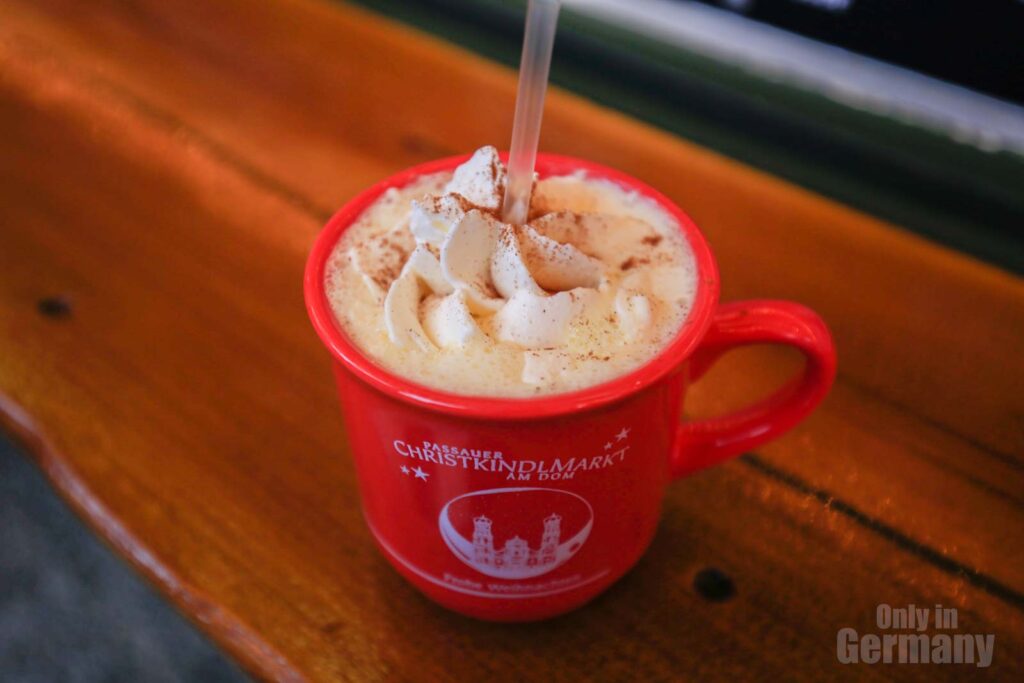
When the winter chill sets in at German Christmas markets, there’s no better way to thaw yourself out entirely than with a steaming cup of Schneemann Punsch. This mulled wine punch, spiked with rum, amaretto, and a luscious creaminess, is a delightful indulgence that will warm both body and soul. Alternatively, if you’re in the mood for a non-alcoholic treat, opt for a comforting cup of heiße Schokolade—hot chocolate, often adorned with fluffy marshmallows. It’s a sweet embrace that promises to melt away the frosty exterior.
For those seeking a simple yet equally pleasant option, consider mead or Met. This honey wine, available in both white and red varieties, can be enjoyed chilled or heated, offering a taste of pure indulgence known as Honigwein or honey wine.
However, if your feet are still frozen after all that pork and sauerkraut, a good shot is just the remedy you need. Herbal liqueur bitters like Jägermeister and Kümmerling serve as the perfect digestif to warm you from the inside out. These potent elixirs not only provide a comforting kick but also add a touch of tradition to your festive revelry.
So, as you navigate the wintery wonderland of German Christmas markets, take a moment to savor these delightful libations. They are more than just drinks; they are a taste of the season’s spirit, offering comfort, warmth, and a touch of merriment to accompany your holiday adventures.
Eierpunsch: A Velvety Delight of German Christmas Markets
Eierpunsch, or egg punch, is a beloved beverage that graces the stalls of German Christmas markets, enchanting visitors with its velvety warmth and delightful flavor. This creamy concoction is a symphony of rich ingredients, each contributing to its unique and festive character.
At its heart, Eierpunsch is crafted from a base of egg yolks and sugar, creating a sweet and luscious foundation. To this, white wine is added, infusing the drink with a subtle tartness and a touch of sophistication. A dash of lemon or orange juice lends a zesty brightness, balancing the sweetness with a refreshing twist.
To elevate the flavor profile, spices are often introduced, with choices ranging from the warm embrace of cinnamon to the fragrant notes of vanilla and cloves. These aromatic additions infuse Eierpunsch with a complexity of flavors, making each sip a delightful exploration of taste.
For those who desire an even creamier experience, Eierpunsch may be enriched with a dollop of cream, further enhancing its indulgent nature. The result is a beverage that is not only satisfying but also a comforting embodiment of the holiday spirit.
As you stroll through the enchanting aisles of a German Christmas market, be sure to seek out a steaming cup of Eierpunsch. It’s more than just a drink; it’s a sip of tradition, a taste of festivity, and a heartwarming reminder that the holiday season is a time to savor life’s sweet moments with joy and delight.
Eierlikör: The Liquid Comfort of German Festivities
In the world of German libations, Eierlikör reigns supreme, holding the honorary title of the country’s counterpart to eggnog or advocaat. This delightful concoction is a beloved treat that graces German tables year-round, making it a versatile and cherished ingredient in both desserts and drinks.
Eierlikör is a thick, smooth, and inviting light-yellow liqueur that captures the essence of indulgence. Its base ingredients include egg yolk and sugar, forming the foundation of its rich and sweet character. But what truly sets Eierlikör apart is its spirited twist, where alcohol, often rum or brandy, infuses it with warmth and depth.
Occasionally, Eierlikör may be further enriched with cream, condensed milk, and a hint of vanilla sugar, adding layers of complexity to its flavor profile. The result is a velvety beverage that is as pleasing to the palate as it is to the soul.
With alcohol content typically ranging between 14 and 20 percent, Eierlikör provides the perfect excuse to indulge and stay warm during the holiday season. Whether sipped on its own or used to enhance the flavors of tortes, cakes, or other delightful desserts, Eierlikör embodies the spirit of festive celebrations.
While Eierlikör may be enjoyed throughout the year, it shines with particular brilliance during the Advent season at German Christmas markets. Here, amidst the enchanting atmosphere and joyful revelry, a cup of Eierlikör is a comforting companion, a sip of liquid warmth that invites you to savor the magic of the moment.
As you navigate the delightful world of German holiday markets, be sure to savor a taste of Eierlikör. It’s more than just a drink; it’s a celebration of life’s sweet pleasures and a reminder that the holiday season is a time to relish every moment with joy and indulgence.
In conclusion, when it comes to the rich tapestry of German Christmas markets, it’s not just about the twinkling lights, festive stalls, and charming traditions—it’s also about the delightful array of beverages that warm both body and soul. From the comforting embrace of Glühwein and the fiery spectacle of Feuerzangenbowle to the creamy allure of Eierpunsch and the indulgent pleasures of Eierlikör, these drinks are more than just libations; they are an integral part of the holiday magic.
You have just explored the festive flavors of Germany through our curated list of “20 Christmas Foods in Germany: What to eat and drink during the holiday season.” Whether you’re strolling through the enchanting aisles of a Christmas market, seeking solace from the winter chill, or simply indulging in the joyous spirit of the season, these beverages offer a taste of tradition, a sip of festivity, and a reminder that the holidays are a time to savor life’s sweet moments. So, as you gather with friends and loved ones, or simply take a moment to immerse yourself in the festive atmosphere, don’t forget to raise a glass to the delightful world of German Christmas market drinks. Cheers to the warmth, the joy, and the magic of the season!





